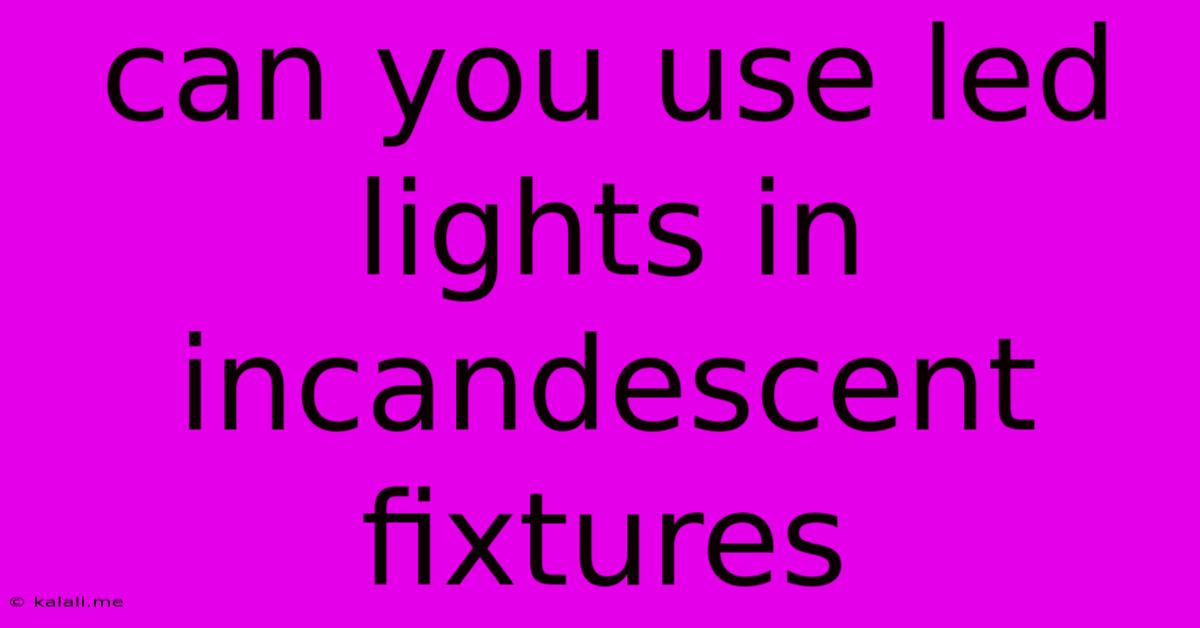Can You Use Led Lights In Incandescent Fixtures
Kalali
Jun 02, 2025 · 3 min read

Table of Contents
Can You Use LED Lights in Incandescent Fixtures? A Comprehensive Guide
Meta Description: Want to swap your incandescent bulbs for energy-efficient LEDs? Find out if your existing incandescent light fixtures are compatible with LED replacements and what safety precautions to take. This guide covers voltage, wattage, heat dissipation, and more.
Switching to LED lighting offers significant energy savings and a longer lifespan compared to traditional incandescent bulbs. But before you make the switch, a crucial question arises: can you use LED lights in incandescent fixtures? The short answer is: generally, yes, but with some important considerations. This comprehensive guide will walk you through the key factors to ensure a safe and successful transition.
Understanding the Differences Between Incandescent and LED Bulbs
Before diving into compatibility, it's helpful to understand the fundamental differences between incandescent and LED bulbs. Incandescent bulbs produce light by heating a filament until it glows, resulting in significant heat generation and lower energy efficiency. LEDs, on the other hand, produce light through electroluminescence, a process that generates far less heat and consumes considerably less energy. This difference in heat output is a key factor in determining LED compatibility with existing fixtures.
Key Factors to Consider When Using LEDs in Incandescent Fixtures
Several factors need careful consideration before installing LED bulbs in incandescent fixtures:
-
Socket Type: Ensure the LED bulb's base (e.g., E26, E12, GU10) matches the socket type of your existing fixture. Incorrect base types will prevent proper installation.
-
Wattage and Voltage: While LEDs consume far less wattage than incandescent bulbs to produce the same amount of light (lumens), the voltage must match. Standard household voltage is typically 120V in North America and 230V in many other parts of the world. Using an LED bulb with an incompatible voltage will damage the bulb or pose a safety risk. Always check the voltage rating on both the bulb and the fixture.
-
Heat Dissipation: This is arguably the most important factor. Incandescent bulbs generate significant heat, and their fixtures are designed to accommodate this. LEDs generate far less heat, but some fixtures may still be too enclosed, potentially leading to overheating and premature bulb failure. Look for fixtures with adequate ventilation. Avoid using LEDs in totally enclosed fixtures unless specifically designed for LED use.
-
Dimmability: If you plan to use a dimmer switch, make sure both the dimmer and the LED bulb are compatible. Not all LED bulbs are dimmable, and using a non-dimmable bulb with a dimmer can cause flickering or damage the bulb. Check the packaging for "dimmable" labeling.
-
Light Output (Lumens): LEDs are often rated in lumens, a measure of light output, rather than watts. Pay attention to the lumens rating to ensure you achieve the desired brightness. You may need a lower wattage LED to achieve the same light output as your previous incandescent bulb.
Types of Incandescent Fixtures and LED Compatibility
-
Open Fixtures: These fixtures, such as pendant lights or exposed bulb fixtures, generally pose no compatibility issues with LEDs. The open design allows for sufficient heat dissipation.
-
Enclosed Fixtures: These fixtures, such as recessed downlights or enclosed ceiling lights, need careful assessment. Overheating is a greater concern. Look for fixtures with ventilation or labeled as suitable for LEDs. If unsure, consult an electrician.
-
Fixture Materials: Some materials, such as plastic, may be less heat-resistant and more susceptible to damage from the (relatively small amount of) residual heat from LEDs. Always check the fixture's specifications and material composition.
Safety Precautions
-
Always turn off the power at the breaker box before installing or replacing any light bulbs. This is a crucial safety precaution regardless of the bulb type.
-
Inspect the fixture for any damage before installing LEDs. Any cracks or loose wiring should be addressed before proceeding.
-
If you are uncertain about the compatibility of your fixture with LEDs, consult a qualified electrician.
By carefully considering these factors, you can safely and effectively transition your lighting to the energy-efficient benefits of LED bulbs. Remember, safety always comes first!
Latest Posts
Latest Posts
-
Were Jesus And John The Baptist Cousins
Jun 04, 2025
-
The Penny In The Bucket Saying
Jun 04, 2025
-
Dumbledore At The Base Of The Astronomy Tower
Jun 04, 2025
-
Can You Feed A Baby In A Car Seat
Jun 04, 2025
-
How To Open A Python Interpreter Bash
Jun 04, 2025
Related Post
Thank you for visiting our website which covers about Can You Use Led Lights In Incandescent Fixtures . We hope the information provided has been useful to you. Feel free to contact us if you have any questions or need further assistance. See you next time and don't miss to bookmark.